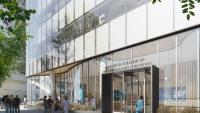New Research Building to be City’s First All-Electric Building of Its Kind
Building combines state-of-the-art medical research with a vision for a more sustainable future for science

Construction begins this summer on New York City’s first all-electric university research building. The building, which will be located east of Broadway at the corner of 167th Street and Audubon Avenue, will house eight stories of laboratories and research facilities, collaboration corners, living walls, and community engagement spaces.
This will be the first university-owned research building in New York City that does not rely on fossil fuels. It incorporates sustainability goals into all aspects of its design and operations and will use significantly less energy than similar buildings of its kind.
“We are so proud to be laying the groundwork for this innovative new research building at Columbia. To create a space that will advance biomedical science, bring us closer to our local community, and help our medical center reduce its carbon footprint all in one is truly remarkable,” says Katrina Armstrong, MD, VP&S dean. “Our purpose as a university is to drive discovery, educate next-generation leaders, and create inclusive partnerships with our community. This new space will offer the best environment for our people to do all three.”
The building’s laboratory floors will have flexible research space and house 32 principal investigators plus their teams of research technicians, postdoctoral researchers, and graduate students. Unique collaboration corners will help facilitate spontaneous interactions and idea-sharing among scientists. Biophilic elements such as green walls of living plants and the extensive use of natural, renewable material will help reduce work fatigue and provide health and environmental benefits. The building will be accessible to community partners, providing ground level space to support community health engagement and research education activities.
Research laboratories typically consume five to 10 times more energy per square foot than an average office building, according to the Department of Energy. At a time when scientists are increasingly concerned about the environmental impact of their research, the building will set an example of a more sustainable future for science. To limit energy consumption, research spaces will incorporate many sustainable design strategies, including high-efficiency lab fume hoods, demand-based controls for lab equipment, and air-source electric heat pumps.
The building is expected to outperform emission limits set by New York City’s Local Law 97 and help advance Columbia University’s Plan 2030 climate goal of achieving campuswide net-zero emissions by 2050.
The building is designed by Kohn Pedersen Fox architecture firm.